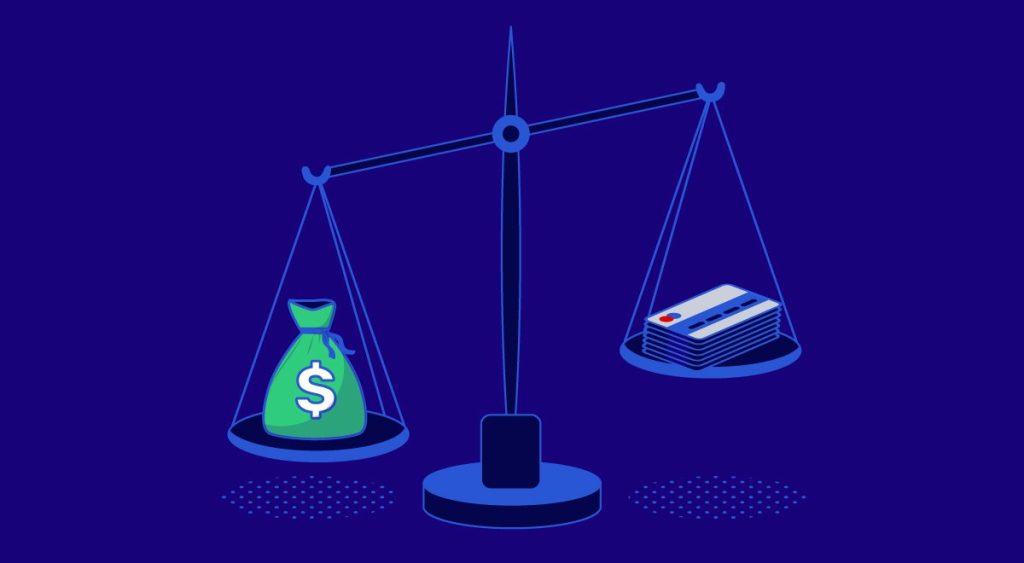If you own a business, you’re going to have to take on debt, eventually. In fact, according to a recent study, the average small business has about $195,000 in business debt. You may need to take out a loan to purchase equipment or have a line of credit with a bank to cover payroll and other expenses until all your invoices are paid. When used wisely, debt can help you achieve success and make your company profitable. However, too much debt can be detrimental to your company’s health and could even cause it to fail. One way you can gauge whether your company is carrying too much debt is by calculating its debt-to-equity ratio. Let’s zero in more closely on business debt, so you can understand the difference between a good and bad debt ratio.
What Is a Debt-to-Equity Ratio?
The debt ratio is used to measure a company’s leverage, meaning how the company is financing its operations with debt instead of with its assets or funds. The debt ratio can be calculated by dividing the total amount of debt a company has by all of its assets. For example, a business that has accumulated $100,000 in assets (such as cash and equipment) and has a total of $25,000 in debt has a debt ratio of .25. A higher debt ratio percentage indicates that a company relies more heavily upon debt, while a lower ratio indicates a company is less dependent upon debt. Debt and its impact on a company are complicated, so a high or low debt ratio can be a good or a bad thing, depending upon the situation.
Using Debt Well
There are many reasons business owners should consider taking on debt to finance their company. Using debt instead of equity investors may enable an entrepreneur to maintain a greater level of control over his or her company and its profits. Equity investors often want to insert themselves into the decision-making process or demand a percentage of a company’s profits, or both. Owners who use debt instead of equity to start their company and keep it running from day to day are able to avoid these types of headaches.
It often makes good financial sense to use debt to help finance your business. For starters, there are big tax incentives for using debt versus equity within a company. In many cases, businesses can deduct their interest on the debt from their taxes, which can lower the company’s cost considerably and make using debt a more practical way to finance a company’s operations. Depending upon the interest rate and the expected rate of return on an asset or other investment the company plans to make, debt can be a relatively inexpensive source of capital, too. Finally, due to the wide array of traditional and online lenders, it’s easier than it ever was for companies to obtain the debt they need to achieve critical business tasks.
Using Debt Poorly
While there are many ways to use debt well within a company, you’ll also know quickly if you have a bad debt ratio, since it can get your business into trouble. If you have too much debt at a high-interest rate, the payments you have to make each month could hurt your company’s cash flow. This could limit your ability to pay other bills or make the required investments to grow your business and make it successful. If business slows down, as it has for many companies during the coronavirus pandemic, then it can be difficult to pay that debt month after month. Defaulting on debts could damage your credit rating, making it more difficult to access the capital you need to grow your business; if you’re unable to recover and pay back your business debts, it could lead to bankruptcy as well.
Debt ratios are often used to gauge the health of a company, as well as how well it’s using debt. In many cases, debt ratios below .4 are considered lower risk, since it means that a business is using sufficient amounts of its capital to run its operation and that it’s managing debt well. Conversely, .6 or higher is often considered a bad debt ratio since, as described earlier, it can be challenging to make payments on higher levels of debt during a slow period in a business. It’s important to note, however, that these rules about good and bad debt ratios are rules of thumb; different industries approach what they consider as acceptable and unacceptable levels of debt in different ways.
Finally, while low debt ratios are generally considered better, it can be considered unwise for companies to have little or no debt, too; many experts believe that if companies don’t have any debt, they may either be too reliant upon equity or may not be positioned to rapidly invest in fleeting opportunities that could give them a competitive edge.
Level Up Your Business with the Right Level of Debt
How you finance a company is one of the most critical decisions entrepreneurs ever make. If you plan to use debt to start your company, make sure you understand what a good or a bad debt ratio is. As you get ready to launch a new business or take yours to the next level, knowing how to use debt correctly can make the difference between success and failure.
The content provided is intended for informational purposes only. Estimates or statements contained within may be based on prior results or from third parties. The views expressed in these materials are those of the author and may not reflect the view of SmartSpending. We make no guarantees that the information contained on this site will be accurate or applicable and results may vary depending on individual situations. Contact a financial and/or tax professional regarding your specific financial and tax situation. Please visit our terms of service for full terms governing the use this site.

